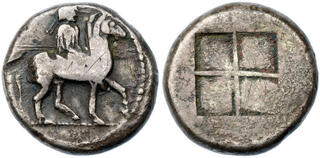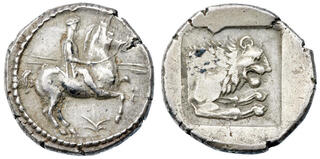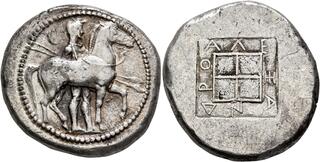Match 1:
Match 2:
| Leu Numismatik AG > Auction 15 | Auction date: 1 June 2024 |
| Lot number: 50 Price realized: This lot is for sale in an upcoming auction - Bid on this lot  | |
| Lot description: KINGS OF MACEDON. Alexander I (?), 498-454 BC. Tristater or Oktadrachm (Silver, 30 mm, 29.47 g), circa 480s-470s BC. Horseman, wearing chlamys and petasos, holding two javelins and walking slowly to right behind bridled horse standing right, left foreleg raised; on the flank of the horse, symbol or monogram (?). Rev. Quadripartite incuse square. AMNG III, p. 49, 6 ('Bisaltai'). S. Brackmann: Alexandros I. oder Bisaltai, in: JNG 65 (2015), pp. 1-8. HGC 3.1, 753. Peykov A3020 ('Bisaltai'). Raymond pl. II, 5. SNG ANS 1. SNG Lockett 1266 ('Bisaltai'). Svoronos, HPM, pl. XII, 6 ('Bisaltai'). Tzamalis, Ethné, Groupe B.2., 129 and pl. 28, 129 (this coin, D51/R52). Very rare. A beautifully toned and unusually well struck example with a fine pedigree. Minor doubling on the obverse and with light scratches on the reverse, otherwise, very fine. Ex Classical Numismatic Auctions 1, 1 May 1987, 30, Sternberg XIV, 24-25 May 1984, 65, Leu 28, 5 May 1981, 72 and Münzen & Medaillen AG XIX, 5 June 1959, 384 ('Magnifique example d'art archaïque, rustique et spontané. D'une grande rareté.'). Given that both the Bisaltai and Alexander I issued this type with the addition of an ethnikon or royal name, the attribution of anonymous pieces like ours remains contentious. Brackmann highlighted reverse die links to pieces bearing the name of the Bisaltai tribe, yet this merely suggests that the coins were produced in the same mint, not that they were issued by and for the Bisaltai, as he himself admits. Many scholars perceive the lack of inscription as suggesting an early production date for the coins. However, it is possible that these coins represent alliance coinages between the Macedonian King and the tribal community, with deliberate omission of names for political expediency. We have adopted the more common attribution to Alexander I here, albeit with a lingering question mark since consensus regarding their origin has yet to be reached. What remains undeniable, however, is that these impressive large silver coins - whether tristaters or oktadrachms - fit well within the broader context of minting large silver denominations in the Thracian-Macedonian region, as previously discussed in the commentary on lot number 40 above. Estimate: 7500 CHF | 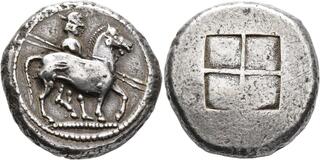 |
Match 3:
Match 4:
| Eid Mar Auctions GmbH > Auction 3 | Auction date: 11 May 2024 |
| Lot number: 46 Price realized: This lot is for sale in an upcoming auction - Bid on this lot  | |
| Lot description: Greek Kings of Macedon. Alexander I 498-454 BC. AR Tetrobol (15mm. 2,24g), c. 492-480/479. Rider, wearing petasos and long tunic, and holding two transverse spears with his left hand, on horse walking to right. Rev. Quadripartite incuse square. Raymond pl. II, 21. SNG ABC 12. SNG ANS 7. SNG Lockett 1268. Very Fine. Coins of this type have been traditionally ascribed to the Bisaltai, but, as noted in the SNG ABC, it is almost certainly an early, uninscribed issue of Alexander I. Very rare. Estimate: 100 EUR Starting price: 80 EUR |  |
Match 5:
| Leu Numismatik AG > Auction 15 | Auction date: 1 June 2024 |
| Lot number: 40 Price realized: This lot is for sale in an upcoming auction - Bid on this lot  | |
| Lot description: THRACO-MACEDONIAN TRIBES, Derrones. Circa 480/75-465/2 BC. Tetrastater or Dodekadrachm (Silver, 38 mm, 39.39 g, 12 h). ΔΕRΟИ Male driver, wearing petasos, holding whip in his right hand and reins in his left, driving ox cart to left; above, crested Corinthian helmet to left. Rev. Triskeles running left; below, palmette; all within shallow incuse square. Jameson 1946 (this coin). O. Masson: Quelques légendes monétaires Grecques, in: SNR 74 (1995), p. 6, fig. 1 (this coin). Peykov A1470. Svoronos, HPM p. 9, 15 and pl. II, 1 (this coin). Tzamalis p. 60 and pl. 8, 92 (this coin, D9/R9). Wealth of the Ancient World (Kimbell Art Museum, Fort Worth, 1983), 61 (this coin). Very rare and among the finest known examples. A wonderful, unusually well struck piece of ferocious late archaic style, with a clear ethnic and a delightful toning acquired from over a century of resting in some of the most prestigious collections. Light doubling on the obverse and with the usual weakness and minor flan faults on the reverse, otherwise, about extremely fine. From the collections of Nelson Bunker Hunt, Part I, Sotheby's, 19 June 1990, 61, C. Gillet ('Kunstfreund', 1879-1972), Bank Leu / Münzen & Medaillen, 28 May 1974, 38 and R. Jameson (1861-1942), and from the 1912 Ishtib (Stip) Hoard (IGCH 355). Apart from their magnificent coins, no source tells us about the existence of the Derrones - neither are they mentioned by any Greek author, nor have they left any epigraphic traces. Thus, the coins remain our only access to their history, and we must deduce the background of their impressive large silver coins from hoard finds. While early numismatic authors placed the pieces in the late 6th century due to their wonderful archaic style, Price and Waggoner demonstrated through the publication of the Asyut Hoard that the coinage of the Derrones belongs to the first half of the 5th century. Further differentiation was achieved by Tzamalis, who could divide the coinage of the Derrones into two groups by comparing various hoard finds, with those featuring the quadratum incusum on the reverse dated to the period before 480/75 BC, while those with the pictorial motifs on the reverse fell into the period from 480/75 to 465/2 BC (A.P. Tzamalis: "Τα νομίσματα των Δερρώνων. Εξέταση της κυκλοφορίας μέσα από τους νομισματικούς 'θησαυρούς'", in: E.P. Siumpara and K. Psaroudakis (eds.): ΘΕΜΕΛΙΟΝ. 24 μελέτες για τον Δάσκαλο Πέτρο Θεμέλη από τους μαθητές και τους συνεργάτες του. Athens 2013, pp. 215-231). This dating helps us to place the coinage of the Derrones in the context of the Persian Wars, the early expansion of the Macedonian Empire under Alexander I (498-454 BC), and the Athenian activities in the northern Aegean. Clearly, the Derrones were among the numerous Thracian-Macedonian tribes that exerted control over the significant silver mines situated in the mountainous hinterlands spanning Macedonia, Paeonia, and western Thrace. It is believed today that the Derrones settled either north of the Macedonian heartland or further east along the upper reaches of the Strymon. But why did these wild mountain tribes strike such large silver coins in the first place, while small denominations were only sporadically minted? The numerous finds of these large denominations in hoards from the Levant and Egypt show that they were not everyday money for local circulation but rather used as weight-standardized bullion. One theory suggests that the Thraco-Macedonian silver coins reached the East through Athenian maritime trade, but Tzamalis proposes another possibility, namely that these large coins were tribute payments from the tribes to the Achaemenids, which would explain their later discovery in hoards found within the boundaries of the Persian Empire. It is not widely known that Thrace and large parts of Paeonia and Macedonia remained under Achaemenid rule even after the devastating defeats of the Persians against the Greek city-states at Marathon, Salamis, and Plataea in 490, 480 and 479 BC, respectively, and thus the European satrapy of Thrace persisted well into the 5th century BC. Tzamalis speculates that the tributes of the local, silver-rich tribes were minted into these large coins and used to finance the regional Achaemenid garrisons. With the soldiers, the coins later traveled to the East, where they became part of the hoards known to us. Whether the Derrones and the other Thracian-Macedonian tribes exported their coins through Athenian intermediaries or through Persian garrison troops, it is certain that these are among the most impressive coins of the 5th century BC. Their sheer size, distinctive haptics and powerful late archaic style - evidence of the ferocity of these tribes - have captivated collectors and numismatists for more than a century. As a result, the finest examples have found their way into many of the most esteemed collections. In the case of our piece, the cover coin of this auction, these were the famous collections of Nelson Bunker Hunt (1926-2014), C. Gillet ('Kunstfreund', 1879-1972), and R. Jameson (1861-1942). Estimate: 25000 CHF | 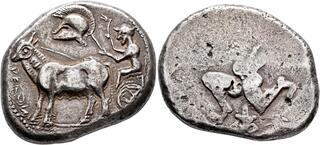 |


